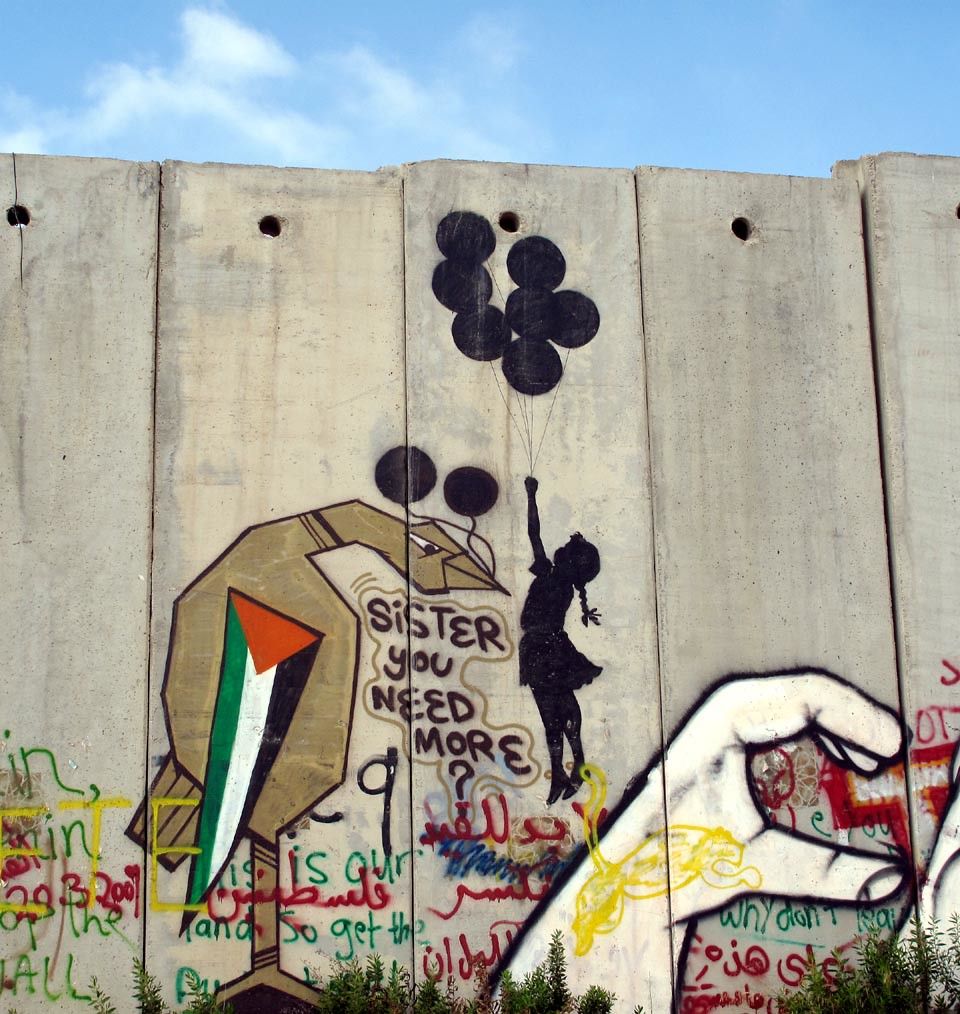Banksy - VM - Willem de Vink
Banksy: Flying Balloon Girl

It is Happening in the Street
by Willem de Vink
I used to go to Israel at least once a year, for more than ten years. On each return I wanted to go back to the Palestinian areas, to witness life in the rough there, to meet those friendly people and also those few courageous Christians. I wanted to see the walls, those concrete blocks standing eight metres high, separating the Palestinians from the Jews. Mostly I wanted to see the resistance on those concrete walls, made visible in drawings, protest captured in images.
Among those visual protests a British artist has left his mark. Banksy has become pre-eminently known for shredding his expensive artwork Game Changer at an auction, but his street art is much more interesting. He exposes human behaviour in the weirdest locations in the world with ironic visual language that everybody understands. Abuse of power, terrorism, consumerism, exclusion, he takes it all on, sometimes with biting pictures but more often with a joke. On the walls of separation in the Palestinian areas he has been working with pictures of protest and hope since 2005. He has drawn holes with a view of a paradise, children trying to climb a ladder to the other side or flying with balloons across the separation, heavily armed Israeli soldiers who are being frisked by little girls.
Banksy’s protest art stands in the tradition of the prophets in the Bible. They did not use stencils and spray paint to express their vision, but they were equally visionaries who conveyed their messages not only in language but also in pictures. Jeremiah did that with a linen belt, with jugs, yokes, and a stone. Ezekiel did the work of a performance artist, acting as cook, hairdresser, refugee, and road builder, sometimes for hundreds of days continuously. And Habakkuk was told to put the message that a righteous person will live by faith on tablets so that all passers-by could see it. They and all the other prophets used all kinds of evocative visual means to deal with the injustice around them and point to the hope that God provides. They often did it in the street, like Banksy.
Jesus also made visible his message in the street. He did that by healing people and raising the dead. In this way he exposed the failure of people to do good to others. At the same time, he demonstrated the goodness of God in Israel. But his influence reaches further. Banksy may make revolutionary ideas visible in places loaded with tension across the world, but Jesus exercises influence that does not simply touch life on the street but touches people in their hearts. By following him, the broken-hearted can be healed and people can begin to love their enemies.
*******
Banksy, Flying Balloon Girl, 2005, ca. 500 x 150 cm, West Bank, Palestine.
Read: 2 Corinthians 3:2-6; Jeremiah 31:31-34; Hebrews 9:14-15; Luke 4:16-21; Matthew 5:43-44.
Banksy (probably born in 1973, his true identity is unknown) is the pseudonym of a well-known British graffiti artist. His artworks are often political and humorous in nature. His works can be found in various European cities, but also in countries like Palestine, Israel, and the United States.
Willem de Vink (Utrecht, b. 1957) is a Dutch speaker, writer, and illustrator. His picture story book Jezus Messias (Jesus Messiah) has been published in more than 200 languages. He also wrote the book Dit is liefde, Vincent (This is Love, Vincent). He recently published the book In het hoofd van de maker, Creativiteit, Kunst, Kerk (In the Mind of the Maker: Creativity, Art, Church).
ArtWay Visual Meditation 24 September 2023


